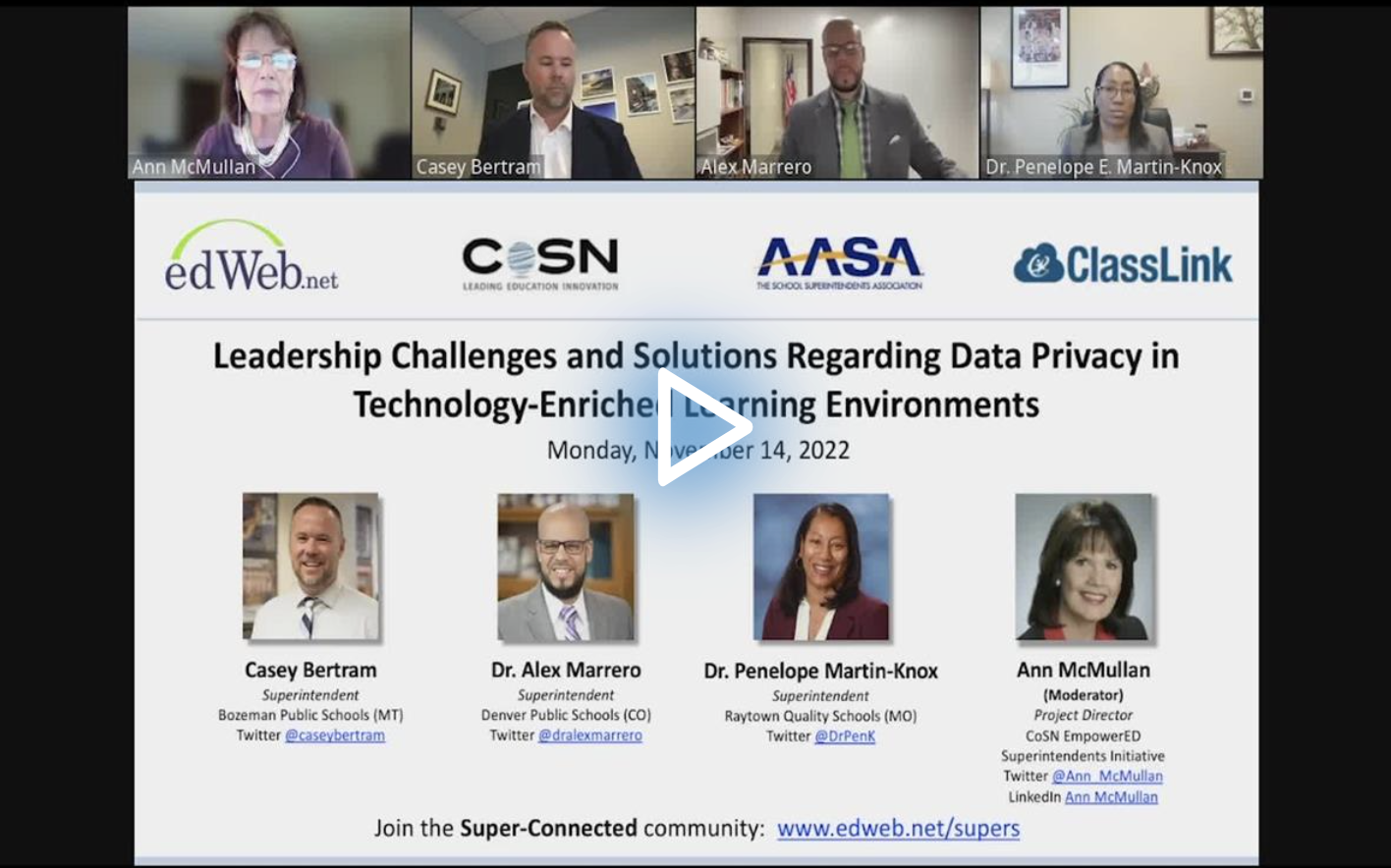Critical Guidelines for Ensuring Data Privacy in Districts
Watch the Recording Listen to the Podcast
This edLeader Panel is presented by CoSN and AASA.
Sponsored by ClassLink
Data privacy, a multi-stakeholder priority for school systems, touches every aspect of operations. Therefore, assessing privacy and compliance policies and practices related to the systemwide use of technology is a continual priority.
During the edLeader Panel, “Leadership Challenges and Solutions Regarding Data Privacy in Technology-Enriched Learning Environments,” three district leaders discussed the five critical guidelines for ensuring data privacy in the use of technology in their districts.
Stay current and compliant with federal and state laws
To provide safe learning environments, district leaders must stay abreast of data privacy regulations at the state and federal levels. The panelists agreed that a collaborative approach with school boards, district leadership, and legal counsel is critical to keeping student data safe.
In addition, being aware of student data guidelines and policies ensures that districts are effectively implementing and sharing that information with all stakeholders to ensure compliance with the IT, assessment, curricula, student services, human resources, and technology vendors.
Address community and stakeholder expectations early and often
Legal issues around data privacy can be overwhelming for the school community. The panelists recommended superintendents provide a clear review of the district data privacy policy and compliance practices with their community early and often. District leaders understand that their communities expect students’ data privacy; however, getting them to turn out for conversations around state and federal privacy regulations can be challenging.
Bringing parents in for discussions such as their students’ devices and the safety of their students on social media can be an opportunity for district leaders to share what the district is doing on the school end to keep their students safe. Also, using various communications platforms and resources such as the district website, student and staff handbooks, and newsletters to parents can ensure that all stakeholders align with district policies.
Keep instructional impacts in the picture
Students’ families, educators, school leaders, and vendors all play a role in striking the appropriate balance between access to learning resources and services and privacy. The balance between needing data to drive instruction and honoring data privacy requires districts to understand the efficacy of programs without giving away student data privacy. The panelists recommended that districts provide high-quality assessment, establish distinct levels of data access, and have robust data privacy agreements with solution providers.
Responsive, responsible privacy administration and management mitigate risk
Continual management of a compliance program that designates rules, procedures, and the individual or group responsible for decisions is the starting point for mitigating risk. Superintendents must work with leaders in their districts around management and compliance.
This collaboration should include convening a data governance committee, performing data breach tabletop exercises, networking with colleagues, and developing robust vetting processes that support district privacy policies. Also, an excellent resource for districts as the foundation of administration and management practices regarding student data is the Student Data Principles, created by CoSN and the Data Quality Campaign.
Training. Training. Training.
Anyone who collects or has access to students’ personal information needs training and resources on how to use student data securely, effectively, legally, and ethically in keeping with district policies and requirements. While most districts are time starved for professional learning, training in bite-sized pieces for staff and teachers, such as onboarding staff at the beginning of the year and when implementing innovative technology, ensures everyone understands the expectations and the intent.
Data privacy training should not be a checkbox at the beginning of the school year. Instead, it should be measurable, ongoing, timely, and relevant to ensure all students learn in safe, educational environments.
Learn more about this edWeb broadcast, “Leadership Challenges and Solutions Regarding Data Privacy in Technology-Enriched Learning Environments,” presented by CoSN and AASA, and sponsored by ClassLink.
Watch the Recording Listen to the Podcast
Join the Community
Super-Connected is a free professional learning community for school superintendents, district leadership, and aspiring district leaders.


ClassLink empowers your students and teachers with instant access to their learning resources. ClassLink® LaunchPad includes a library of over 6,000 single sign-on apps and instant links to file folders at school and on Google, Office 365, Dropbox, and Box cloud drives. ClassLink Roster Server easily and securely delivers class rosters to any publisher using open technology standards. ClassLink Analytics gives decision makers the usage data they need. ClassLink is ideal for 1 to1 and BYOD initiatives.
Blog post by Eileen Belastock, based on this edLeader Panel






Comments are closed.